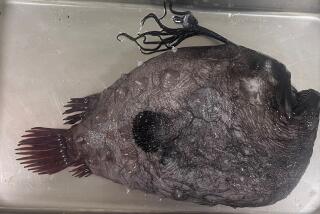A sale, a fishy tale, and suddenly imaginations of deceit run deep
In writing recently about the Pasadena Art Alliance Treasure House sale, I made note of a curious relic that was displayed in the library.
“I always enjoy the library most,” I observed. “The women seem to use the library to display the sort of things that men keep, for mysterious reasons, until they die; and then their wives throw them out.”
The particular “thing” that had caught my eye was “a fish in a glass box with a label reporting that it weighed 1 pound, 13 ounces, and had been caught by A.E. Stamford on July 21, 1931, at Paxton.”
And I added: “For more than 50 years it had sustained some exultant memory; and now it was discarded.”
I remember trying to look up Paxton in my atlas, hoping to find out exactly where Stamford had caught his fish; but no such place was listed. I assumed it was too small.
I believe that I now may know not only where this dubious treasure was caught, but also the circumstances of that long-ago catch.
My clue comes from Joy Burkholder, who moved from Los Angeles seven years ago to the small rural community of Greenville, in the Sierra Nevada. Since then a friend in Los Angeles has kept her abreast of events here by sending an occasional letter with newspaper clippings.
“In a recent letter,” she writes, “was a copy of your May 2 article telling of the Treasure House sale. In it you mention ‘a fish in a glass box. . . .’ This was of great interest to my family, because my younger brother, Ron Schwartz, and his wife, Jane, and partner, Ronnie Pound, for the past 12 years have owned Paxton Lodge, located on the Feather River in Plumas County; and this is no doubt where this very fish was caught--and four years before any of these folks were born!”
So that, perhaps, establishes the location. But Mrs. Burkholder goes on: “Our close friend Wayne Batchlor, who was born and raised in the Feather River Canyon and is ‘older than the rocks’ (actually only 66), has entertained us many times with the story of how he and his brother were hired at ages 12 and 14 to catch fish for the visitors at Paxton.
“It seems that the gentlemen were more interested in the indoor sports available (gambling, drinking and young ladies) than the fishing trip they were supposedly on, and needed a catch they could take home to their wives.
“Wayne says it took him quite a few years to realize why those fellas hired him to catch fish and then drag their brand new boots through the mud before going home.
“I’m not saying your Mr. Stamford was one of those non-fishing anglers; he may well have caught his 1-pound, 13-ounce beauty himself. I just wanted to tell you how your article was enjoyed by a lot of folks, over a cold beer, and how it got the old stories rolling again, by the old-timers in the canyon.
“By the way. Did the fish in the glass box sell? Would be fun to see it back home at Paxton, wouldn’t it?”
I do not know who A.E. Stamford was (or perhaps still is); and I am not going to suggest that he did not catch that fish.
I am certainly not going to suggest that back there in 1931, when he made that fishing trip to Paxton, Stamford actually spent his holiday indoors at such sports as gambling, drinking and hanky-panky with young ladies.
On the other hand, I suppose it is possible that he did have the fish caught for him, and had it stuffed and put in the glass box as proof of his story, when he returned to his home, that he had spent his time fishing.
It did seem a very small fish to authenticate an entire vacation. Unless it was one prized for its rarity and elusiveness, I would think that any gentleman would have thrown it back in.
Can it have been so unusual a catch that it was kept on the man’s wall for 50 years to remind him of either his fishing skill or his macho way with the cards, the booze and the ladies?
Maybe it was Stamford’s way of keeping in touch with his alter ego. Maybe he was ground down in the routine of family life and a dull job, and he liked to look up at the little fish on his library wall to remind him of that time in the mountains when he was wild and free.
If I were a wife, I would look with skepticism at any trophy bought home by my husband from a vacation spent with “the boys.” Did he really catch that swordfish in the Gulf of California? Or is it actually one caught by a hired fisherman while he was boozing in the cockpit with a topless dancer from Mexicali? I have always wondered why any man would hang a dead fish over his fireplace anyway. Perhaps indeed the reason for these queer trophies is to quiet the suspicions of jealous wives.
Anyway, I telephoned one of the Art Alliance women to find out what had happened to the little fish in the box.
“Oh, someone bought it,” she said. “The first night.”
Now I am really puzzled. What could anyone want with a 1-pound, 13-ounce fish that he hadn’t caught and hadn’t even paid anyone to catch?
I wonder. Is another wife about to be deceived?
More to Read
The biggest entertainment stories
Get our big stories about Hollywood, film, television, music, arts, culture and more right in your inbox as soon as they publish.
You may occasionally receive promotional content from the Los Angeles Times.










